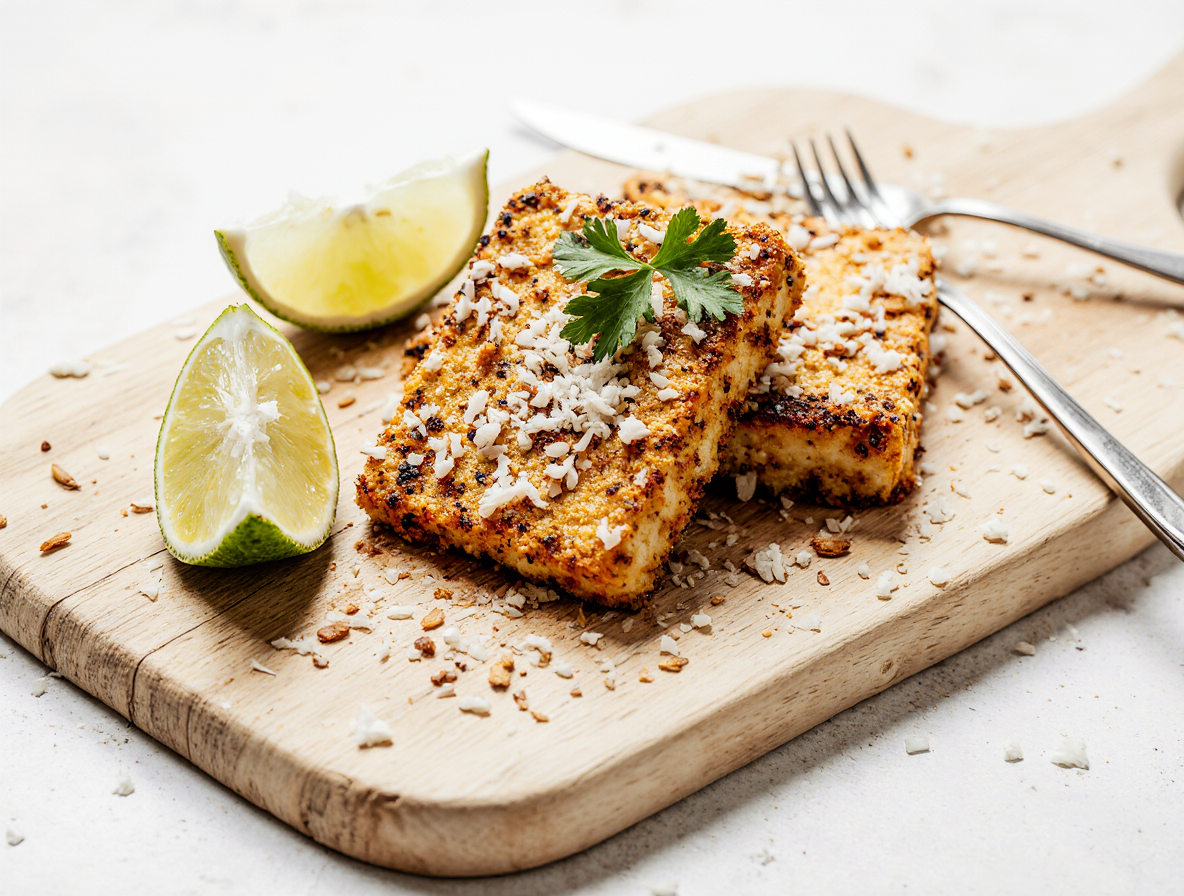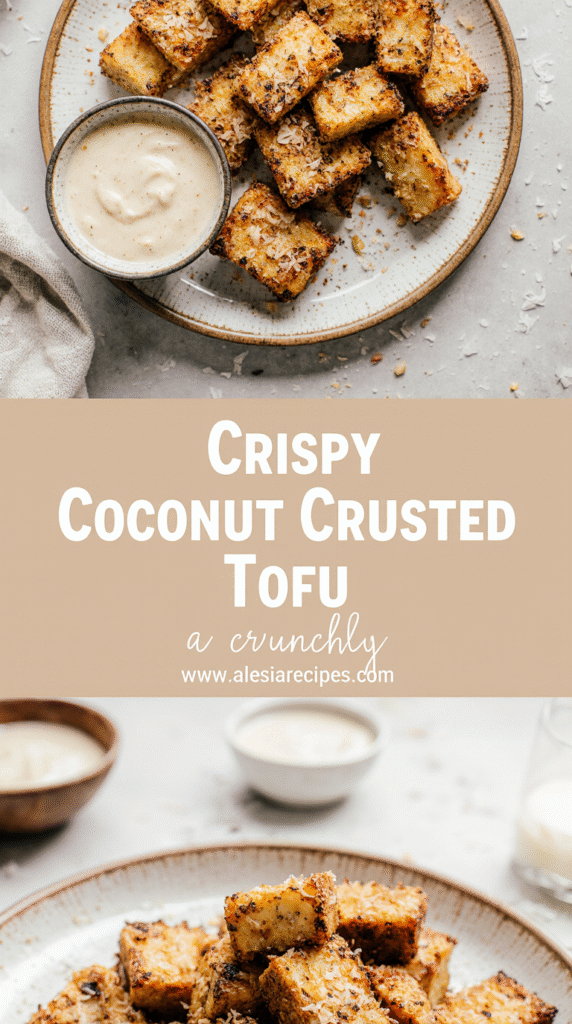The Secret to Perfect Crispy Coconut Tofu (Chef-Approved Method)
Crispy coconut tofu delivers that perfect contrast of textures—golden, crunchy exterior with a tender center that’s absolutely irresistible. I’ve been perfecting this plant-based protein powerhouse for years, and it packs an impressive 10-18 grams of protein per serving. What’s even better? You can have this delicious coconut crusted tofu on your table in just 25-35 minutes[-4].
Tofu has been enjoyed for over 2000 years, but many home cooks still struggle to achieve that restaurant-quality crispiness. In this guide, I’ll share my chef-approved method for creating the ultimate coconut fried tofu that pairs wonderfully with various dipping sauces like sweet chili or pineapple. Furthermore, I’ll walk you through every step—from pressing techniques to the perfect breading combination of coconut and panko. Whether you prefer baking, air frying, or traditional frying, you’ll learn how to avoid the dreaded soggy crust while maintaining that satisfying crunch.
Choosing and Preparing the Right Tofu
The foundation of perfectly crispy coconut tofu begins long before you heat any oil. Success starts with selecting the right type of tofu and preparing it properly. Let me guide you through the essentials that will transform your tofu from bland to extraordinary.
Why extra firm tofu matters
When creating crispy coconut tofu, the type of tofu you select makes all the difference. Extra-firm tofu is absolutely essential—it’s the only option that will maintain its shape and achieve that golden crust we’re after. This variety contains less moisture and has a denser, more compressed texture, making it significantly easier to crisp up.
Extra-firm tofu holds together during cooking instead of crumbling apart, which is crucial when you’re aiming for perfectly crusted pieces. Additionally, its sturdier structure allows it to withstand the coating and cooking process without falling apart. Never use silken or soft tofu for crispy recipes—these varieties are too delicate and contain far too much moisture to achieve any crispiness.
How to press tofu for best texture
Even extra-firm tofu contains considerable water—approximately 80% of its content. This excess moisture is the enemy of crispiness, so pressing is a non-negotiable step. Pressing tofu removes water, allowing it to absorb more flavors and develop a chewy, satisfying texture.
Here’s my preferred method: cut the tofu block into slices or pieces before pressing. This strategy exposes more surface area, which allows more moisture to escape in less time. For best results, place tofu pieces on paper towels, cover with additional towels, and set a heavy object (like a cast-iron pan) on top. Press for at least 30 minutes, though I find 60 minutes yields noticeably better results.
If you’re a regular tofu consumer, consider investing in a tofu press. These simple devices apply even pressure, prevent cracking, and capture the excess water. Either way, never skip this critical step—pressed tofu absorbs marinades better and crisps up beautifully.
Freezing tofu: a game-changing trick
Perhaps the most transformative technique for tofu is freezing it before cooking. This simple process completely changes tofu’s texture, making it spongier, chewier, and more “meat-like”.
Here’s the science: when tofu freezes, the water inside forms ice crystals that expand and create tiny pockets throughout the tofu. After thawing, these pockets remain, turning your tofu into a flavor-absorbing sponge that soaks up marinades and sauces remarkably well.
To try this technique, simply place tofu (either whole or in pieces) in the freezer until solid, about 4-6 hours. Then thaw it in the refrigerator before pressing out the excess moisture. The result is denser, more porous tofu that absorbs flavors better and maintains a satisfying chew when cooked. This method is particularly effective for coconut crusted tofu recipes where you want that perfect balance of crispy exterior and chewy interior.
Marinating and Flavoring the Tofu
After mastering the art of preparing your tofu, the next crucial step is infusing it with flavor. The marinade stage transforms bland tofu into a flavor-packed delight, setting the foundation for your crispy coconut tofu creation.
Simple marinade ingredients that work
The most effective tofu marinades use basic pantry staples that create maximum impact. A stellar marinade requires just five key components: soy sauce (or tamari for gluten-free), a sweet element like maple syrup or coconut sugar, an acid such as rice vinegar or lime juice, sesame oil for richness, and aromatics including garlic and ginger. These fundamental ingredients create depth without overwhelming the delicate tofu.
For everyday marinades, simply whisk together ¼ cup soy sauce, 2 tablespoons sweetener, 2 teaspoons sesame oil, 2 teaspoons rice vinegar, and fresh ginger. This balanced formula penetrates the tofu effectively, especially after it’s been properly pressed.
How long to marinate for maximum flavor
Timing matters considerably when marinating tofu. The minimum effective marination period is 30 minutes, although even just 15 minutes will yield decent results. Nevertheless, for truly transformed tofu, aim for at least 1-2 hours in the refrigerator.
Many chefs recommend overnight marination for superior flavor penetration. Surprisingly, some tofu enthusiasts have achieved excellent results with extended marination—up to 2 days in some cases. However, beyond 4 hours, the tofu may absorb too much marinade, potentially resulting in less crispy results.
Sweet and salty balance: soy, lime, and coconut sugar
The magic combination for coconut crusted tofu specifically lies in balancing sweet coconut sugar with savory soy sauce and bright lime juice. This trio creates a complex flavor profile that perfectly complements the coconut coating to come.
To prepare this specific marinade, combine soy sauce with coconut sugar in a small bowl and heat briefly until the sugar dissolves completely. Subsequently, add fresh lime juice and grated ginger. This mixture should completely coat your pressed tofu pieces, which should then marinate for at least two hours.
Remember to save your leftover marinade—it can be transformed into a delicious dipping sauce by adding a cornstarch slurry (2 tablespoons water + ½ tablespoon cornstarch) and heating until thickened. This additional step enhances your final coconut fried tofu dish with a complementary sauce.
Breading and Cooking Methods
Now that your tofu is properly pressed and marinated, let’s transform it into crispy golden perfection with the ideal breading and cooking techniques.
Making the perfect batter
The secret to crispy exteriors starts with a starch coating. Cornstarch is exceptional for absorbing moisture and creating that distinct crispy coating. Potato starch, tapioca starch, or arrowroot powder all work equally well. For coconut tofu specifically, mix non-dairy milk with lime juice, flour, garlic powder, and salt to create a pancake-like batter.
Coconut and panko: the ultimate crusted tofu combo
Combine shredded coconut with panko breadcrumbs for the perfect crust. Panko creates a lighter, airier coating because it’s made from crustless bread. This duo delivers superior crispiness compared to regular breadcrumbs alone. Press the mixture firmly onto each battered tofu piece to ensure complete adhesion.
Baking vs. frying vs. air frying
Each method offers distinct results:
- Baking: 400-425°F for 25-30 minutes, flipping halfway (15 minutes one side, 10-15 minutes other side)
- Air frying: 380-400°F for 15 minutes (7 minutes per side) – cuts cooking time in half
- Pan frying: Medium-high heat until golden brown (3-4 minutes per side)
Avoiding soggy crust: spacing and flipping tips
Never overcrowd your cooking surface—proper spacing allows moisture to escape rather than steam. For frying, ensure oil is hot enough (sizzles when testing with a small piece). Cool fried tofu on a wire rack or paper towel-lined plate to maintain crispiness.
Serving Ideas and Dipping Sauces
Once your coconut crusted tofu achieves that golden perfection, the possibilities for serving are virtually endless! Let me share my favorite ways to showcase this crispy delight.
Best pairings: rice, veggies, and bowls
Your crispy coconut tofu truly shines when served over fluffy jasmine or basmati rice – I find this combination creates the perfect foundation. For a lighter option, try cauliflower rice which keeps dishes from feeling too heavy. Moreover, create complete meals by adding steamed broccoli or edamame for extra protein and texture. Lettuce wraps offer a refreshing alternative – simply drizzle with sauce and sprinkle with green onions.
For vibrant bowls, combine your coconut fried tofu with quinoa, avocado slices, cucumber, and green onions. These ingredients create balanced meals perfect for weeknight dinners or meal prep lunches that stay fresh for up to 4 days.
Fried tofu dipping sauce: sweet chili or pineapple?
Sweet chili sauce provides that perfect balance of sweetness and heat that beautifully complements crispy coconut tofu. Alternatively, try a homemade pineapple dipping sauce – sauté garlic, ginger and chili pepper in sesame oil, add canned pineapple, soy sauce and water, then simmer until flavors meld.
How to store and reheat leftovers
Store leftover crusted tofu in an airtight container for 3-4 days. Upon reheating:
- Oven: 350°F for about 10 minutes
- Air fryer: Quickest method for restoring crispiness
- Microwave: Fastest option but won’t maintain crunchiness
Remember, reheated tofu won’t be quite as crispy as freshly made, yet will still taste delicious.
Conclusion
After trying these techniques, you’ll never struggle with soggy or bland tofu again. Crispy coconut tofu stands as one of the most versatile plant-based proteins you can master in your kitchen. The combination of proper pressing, thoughtful marinating, and the perfect coconut-panko coating creates that restaurant-quality texture many home cooks find elusive.
My journey to perfecting this dish taught me that patience during the preparation stages pays off tremendously in the final result. The extra time spent pressing and marinating transforms ordinary tofu into something truly special. Additionally, the freezing method might seem like an unnecessary step, but once you experience the chewy, flavor-absorbing quality it creates, you’ll likely make it part of your regular routine.
Whether you choose to bake, air fry, or pan fry your coconut tofu, each method offers its own advantages. The air fryer certainly wins for convenience, while traditional frying delivers that unmatched golden exterior. Regardless of your cooking method, proper spacing remains the key to achieving that satisfying crunch.
This dish adapts beautifully to countless meal ideas – from rice bowls to wraps to simple appetizers with dipping sauce. Your crispy coconut tofu can become a weekly staple that even tofu skeptics will eagerly devour. Therefore, don’t hesitate to experiment with different marinades and serving styles until you find your perfect combination.
Mastering crispy coconut tofu ultimately gives you a reliable, protein-rich option that fits nearly any cuisine style. The techniques shared here apply to countless other tofu preparations as well, making your plant-based cooking repertoire that much stronger. Try these methods this week – your taste buds will thank you!
FAQs
Q1. What’s the key to achieving crispy tofu? The key to crispy tofu is proper preparation. Start by pressing extra-firm tofu to remove excess moisture, then coat it with cornstarch or a similar starch before cooking. Ensure your cooking oil is hot enough and avoid overcrowding the pan to allow moisture to escape during cooking.
Q2. How can I make restaurant-style crispy tofu at home? To achieve restaurant-style crispy tofu, coat pressed tofu cubes in a mixture of cornstarch and salt. Pan-fry the coated tofu in hot oil for about 4-5 minutes per side until golden and crispy. For added flavor, marinate the tofu before coating and frying.
Q3. Is it better to use cornstarch or flour for crispy tofu? Cornstarch is generally preferred for achieving the crispiest tofu. It creates a crunchier coating compared to regular flour. However, you can also use potato starch, tapioca starch, or arrowroot powder as alternatives that yield similar results.
Q4. Why isn’t my tofu getting crispy? If your tofu isn’t crisping up, it could be due to excess moisture or insufficient oil temperature. Make sure to press the tofu thoroughly before cooking and ensure your oil is hot enough. Also, avoid overcrowding the pan, as this can lead to steaming instead of crisping.
Q5. What’s the best way to serve crispy coconut tofu? Crispy coconut tofu pairs excellently with jasmine or basmati rice. For a complete meal, add steamed vegetables like broccoli or edamame. It’s also delicious in lettuce wraps or bowls with quinoa and avocado. Serve with a dipping sauce like sweet chili or homemade pineapple sauce for extra flavor.


